The Granary Apartments
1901 Callowhill Street
There are several historic buildings in the Baldwin Park neighborhood, the Mint building and the Parkway Central Library being two examples. There are businesses, like the Baldwin Locomotive Works and later I-T-E, that are now gone but provided thousands of jobs. There are famous folks who lived in the neighborhood, like Robert Carson and John B. Stetson, and their homes are still with us. Then there are the hundreds of rowhomes used as boarding houses to provide lodging, food, and laundry services to the now anonymous workers who assembled those marvelous contraptions like locomotives. The block between Callowhill and Shamokin Streets and between 19th and 20th Streets is one of those boarding house blocks that lasted from the 1850s until 1986. This article will sample some of the stories from the people who lived there on the site now occupied by the Granary Apartments.

The block looking northeast from the corner of Callowhill and 20th Streets in May of 2025.
On the right is the Granary Apartments building. The red brick buildings in the center date from the 1850s. The concrete granary, built in 1925 after fire consumed the Civil War-era wooden granary there, is on the left.
Callowhill Street turns into Pennsylvania Avenue at this corner, a constant source of confusion for tourists.
The design, by DAS Architects, met with the 2014 approval of Philadelphia Inquirer critic Inga Saffron who noted the matching crenellated rooflines on the old and new granaries.
Other articles on this website have already mentioned a few of the addresses on this block.
-
The concrete granary at 407-411 North 20th Street has a well-documented history here, and insights can be gained by reading that article before this one.
-
The Spring Garden Fire Engine Company #41 moved to 1903 Callowhill Street in 1864.
-
James Dinan died at 1933 Callowhill Street in 1886, leaving his 11-year-old son Frank T. Dinan (1875-1937) an orphan. Frank became an undertaker in 1895 and his family business has had the longest tenure in the neighborhood.
-
The State historical marker at 1937 Callowhill Street honors Frank Piasecki (1919-2008), a pioneer in rotary aircraft development who had his first office there.
The lesser known folks who lived on the block will be discussed chronologically, but first let's look at the more distant past.
A quick historical summary:
The Lenni Lenape and their ancestors occupied the lower Delaware valley for millennia before the Europeans arrived. From 1682 to 1787 William Penn and his family owned the land just north of Vine Street extending from 19th Street to Lemon Hill. In 1737 his son Thomas Penn built Springettsbury Manor near the location of today's City View Condominiums. Penn's estate was sold to Robert Morris in 1787 and the manor burned down in 1794. Morris went bankrupt and his land was sold off in parcels. The equivalent of today's Center City did not extend much further west than Independence Hall at that time, but when Matthias Baldwin moved his factory to Broad and Hamilton Street in 1835, housing for his expanding workforce gradually followed. By 1859 the 1900 block of Callowhill Street was completely built out, mostly with three-story single-family houses accommodating first-floor retail.

Portion of 1796 map juxtaposing the current site of the Granary Apartments (the blue rectangle) on the map. Callowhill Street runs horizontally on the bottom. 19th Street (then called Schuylkill Fourth) bisects the image vertically. The proposed and partially built canal of Robert Morris separates Springettsbury Manor from what is now the Granary Apartments. The pond in center is about the location of today's Baldwin Park.
19th Street separated the Springettsbury estate of Thomas Penn from the Hamilton estate at Bush Hill. The Granary Apartments are in what was the southeast corner of Penn's 300-acre estate, which went all the way to what is now Lemon Hill.
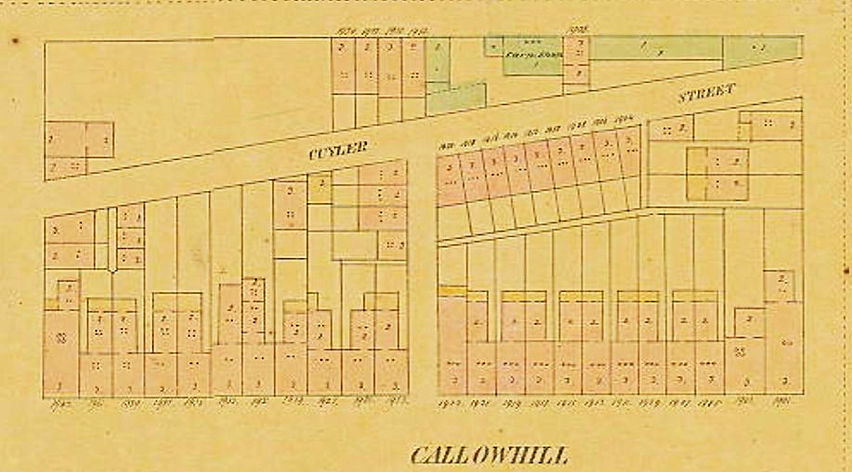
Portion of 1859 map
Cuyler is today's Shamokin Street. North is at the top. 20th Street runs vertically on the left for this and all the following maps. The street running mid-block between Callowhill and Cuyler Streets was originally called Middle Alley, then changed to Newbold Street in 1858, and then to Uber Street in 1897. It was officially vacated in 2007.
Pink signifies brick construction and yellow signifies wood. The rear wooden structures were privies.

Portion of 1901 map
Shamokin Street has filled in with brick stables (marked by an X). In 1899 Thomas Stone, age 40, fell through a trapdoor in the hayloft at 1927 Callowhill and broke his neck.

Photo circa 1890 showing the southwest corner of 19th and Callowhill Street.
The former Fire Engine No. 18 is the second building from the right. In 1900 it moved across the street to 1920 Callowhill Street.
The corner building in right foreground was Charles McNally's paint store.
The Globe Laundry at 1905 Callowhill Street would become an oyster house in the 1920s, then a sandwich shop in the 1960s, and then the Hill Street restaurant in 1984.
The adjoining 1907 Callowhill Street is mentioned in our article here as the home of a margarine-selling ring in 1907 and in 1916 as the home of bartender-beater Daniel Quinlan at what is now the Rose Tattoo. The darker awning is at 1911 Callowhill which was a restaurant at the time of the photo. Other businesses on the block included cigar stores, barbers, plumbers, candy shops, upholsterers, shoe stores, tailors, butchers and, of course, saloons.
A Block of Boarding Houses
Boarding houses are rare today, at least legal boarding houses. Depending on services available, they are also termed rooming houses, lodging houses, furnished-room houses, single-room occupancy (SRO) houses and are defined as rent-by-the-room buildings where three or more unrelated people rent single rooms and share bathroom and sometimes kitchen facilities. The current need for a zoning variance, even in areas zoned for multifamily-housing, plus neighbors' opposition has severely limited the availability of legal boarding houses in today's Philadelphia. In the late 19th century, however, our neighborhood was full of boarding houses, though only later on the 1900 block of Callowhill Street. Besides these commercial boarding houses, many families let out extra bedrooms to unrelated or related lodgers. According to the 1910 census, only two houses on the block were owner-occupied, those being 1943 and 1905 Callowhill. The rest were rented by families with relatives and the occasional boarder. For example, in 1910 Albert Murphy owned 1933 Callowhill Street and lived there with his wife, 9-year-old daughter Gertrude, his mother-in-law, his brother-in-law, and a boarder. By 1915 Albert owned the building free of a mortgage. He also purchased 1905 Callowhill in the year 1925. His daughter Gertrude would later, under her married name Gertrude Phelan, own the whole block, as detailed below.
Our article about accused serial-killer Bridget Carey already mentioned the twelve boarders she had at 1842 Hamilton Street (now the northwest corner of Matthias Baldwin Park). The boarding house was owned by an absentee landlord and leased to Carey to manage. This sixteen-foot-wide three-story house was similar to the rowhomes along Callowhill Street. The matron of the house would set the rules, supply lodgers a small furnished room, and if desired, supply meals to boarders and laundry services. Meals for lodgers could be obtained at any of the many eateries on the block. Lodging instead of boarding allowed the lodger to come and go without the need to be tied to a boarding house meal timetable. Only the nightly curfew restricted their freedom. Then as now the rooms were mostly filled with single men and women trying to save money while they worked low-wage jobs. Rooms could be rented to two people at once, or bedrooms could be separated by thin walls to establish more single rooms. In the 19th century a one- or two-hole privy would be in the back of the house. Another previously mentioned boarding house was at 1820 Hamilton Street directly across from Garretson Hospital. That boarding house was occupied by a matron and thirteen nurses in the 1910 census! Baths were sometimes offered in boarding houses weekly for a price, but after 1895, when the Philadelphia Baths Association was formed, residents could go to the nearest bath house at 718 Wood Street and get a shower for five cents or a tub bath with soap and towel for ten cents.
Young folks in our neighborhood today look askance at sharing a modern bathroom with one roommate, let alone sharing an outhouse with ten fellow lodgers. The forced intimacy in boarding houses often allowed new immigrants to quickly assimilate into American life. Sometimes the forced intimacy turned into voluntary romance and marriage. Leslie Willis and Margaret Wilson of 1941 Callowhill were married in 1915. By the 1950s most of the boarding houses had been converted into apartments, but resident interactions fostered romance. In 1958 Helen Simms, age 27, of 1919 Callowhill married 21-year-old William Thompson of the same address. Helen's sister Adelaide at 1919 Callowhill would marry 21-year-old Leonard Harris from around the corner at 238 North Uber Street the following year. In 1959 19-year-old Geraldine Dunlap was married to 24-year-old Edward Morgan while both were living at 1915 Callowhill. Boarding house matrons could also play matchmaker locally, or act as marriage broker for individuals from the same country but separated by the Atlantic Ocean.
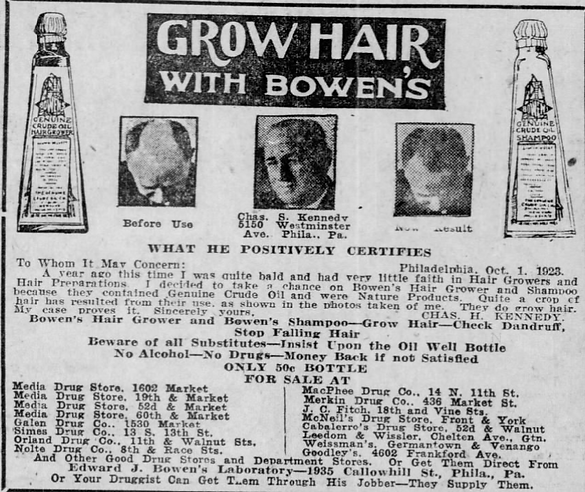
Ad from the March 9, 1924 edition of the Philadelphia Inquirer.
There were several businesses on the block that were run out of lodgers bedrooms and not the first floor retail establishments. Who knew genuine crude oil grew hair and killed dandruff!!??
Tragedies on the Block
In 1888 Patrick Logue at 1919 Callowhill was struck and killed by a train of the Philadelphia and Reading Railroad. This death and the 300 other railroad related deaths each year would lead to a major infrastructure project in our neighborhood. In 1898 a neighborhood project to place the Pennsylvania Avenue below the street level was completed. What is now called the Callowhill Cut was completed in two years and included the tunnel to the west and the elevated rail line to the east. Many of the workers lived in nearby boarding houses. The house at 1931 Callowhill Street had two victims of the project in 1898. Thomas Crowley had his head crushed in the chains of a steam shovel. Fred Stanley also suffered a severe skull fracture with his recovery status unknown.
Trains were not the only cause of pedestrian deaths in the Philadelphia of the late 1800s. Electric trolleys were initiated in 1892 and spread quickly until the last horsecar line in the city ended running on Callowhill Street in 1897. In April of 1895, thirteen-year-old Willie Grant of 1937 Callowhill Street became the 70th fatality from trolleys when the lad was struck and beheaded by a trolley at 15th and Race Street.
Tragedy struck again in 1924, when a fire completely consumed the wooden granary at 407-409 North 20th Street. The houses along the western end of the 1900 block of Shamokin and Callowhill Streets were evacuated for a few days until the embers were cold. Luckily, the burning granary collapsed into itself and none of the surrounding houses caught fire. The replacement concrete granary was constructed by 1925, as described in our article here.

Art Museum
Our neighborhood as seen in 1925 aerial photo. The date can be inferred from the image because the wooden granary burned to the ground in 1925 and was quickly replaced with the current concrete granary. This image shows the first two stories of the concrete granary completed. Other buildings are labeled with links to articles on our website.

Aerial photo from here in 1928. Uber Street runs north from Callowhill Street to Shamokin Street in midblock. There are no vacant lots.
The concrete granary in upper left is three years old at this time.
In the year 1933 the first building on the block to be demolished was at 1925 Callowhill Street, then owned by Mrs. Emma C. "Ma" Bergdoll, widow of Louis Bergdoll of brewery fame. At the time, Ma's son, Grover Cleveland Bergdoll, was living in Germany to avoid arrest for draft-dodging in the United States. When Grover was initially convicted of draft dodging in 1920, after five months in prison he gave a story to authorities that he had a cache of buried gold that he would like to retrieve. During the temporary release from prison he escaped from custody and left the country. The "pot of gold" was carefully searched for during the demo of 1925 Callowhill, according to newspaper accounts of the time.

This is the northwest corner of Callowhill and Uber Streets in 1955. The cars are parked in the small surface parking lot created by the demolition of 1925 Callowhill in 1933.
No gold was ever found here.
Coincidentally (or not) 1923 Callowhill Street, directly across Uber Street from 1925 Callowhill, was purchased by the J & P Baltz Brewing Company in 1893. Baltz had its brewery at 31st and Thompson Streets in Brewerytown from the years 1881 to 1920. Corner buildings made excellent saloon locations. There was a saloon at 1925 Callowhill but 1923 Callowhill seems to have been rented to newspapers as ad offices.

The opposite corner: View looking east down Callowhill Street from Uber Street.
1923 Callowhill Street is the first building and in 1955 functioned as a children's shelter. In the late 1880s and early 1900s it had functioned as a branch advertisement office for the Public Ledger and then the Philadelphia Inquirer. People would place and respond to ads at this physical location before telephones were common.
Race
Newspaper ads in the first half of the 20th century could be so racist, ageist, sexist and creedist that they would shock our modern value systems. Some of the ads were based on pure prejudice. Some were based on financial returns. Some were based on both.

"Situation Wanted" ad from the April 30, 1916 edition of the Philadelphia Inquirer
This woman lived at 1941 Callowhill and probably disclosed her race in the ad to avoid showing up for the interview and being instantly turned away. Many ads looking for work similarly disclosed the fact they were Irish. Some took advantage of the prejudices by stating in the ad that they were white or Protestant.

Want ad from the June 4, 1925 Philadelphia Inquirer
One would like to think this was an early affirmative action program, but more likely race is mentioned in order to get cheaper labor. Similar ads specifically sought a "half-grown girl" or "newly arrived Irish girl" for housekeeping. Unskilled labor brought low wages, but even lower for those who didn't have many choices in the workplace.
1927 Callowhill Street, like most of the rowhomes on the block, was a boarding house with first floor retail. It was demolished in 1959.


Ad on top for a rental at 1931 Callowhill in the March 8, 1942 Philadelphia Inquirer
and on bottom for the sale of 1941 Callowhill Street in the December 6, 1943 Philadelphia Inquirer.
J. M. Brewer, working for the mortgage lender Metropolitan Life Insurance Company, prepared a famous, or infamous, map in 1934 that classified loan riskiness by neighborhood. The quality of the housing stock, but also whether the dominant population was Colored, Italian, or Jewish was noted on the color-coded maps. Almost all the neighborhoods between Spring Garden Street and Callowhill Streets from 10th to 20th were classed as letter D or E, the two lowest grades (E was the letter grade for "decadent").
The Federal Housing Administration, formed in 1934, also used these maps to decline mortgage insurance for housing in Black neighborhoods.

Detail from 1934 Brewer map.
The legend for the map is below. Solid red shapes indicate industrial sites. In 1934 our neighborhood, according to the map, had few minorities and no "conspicuous nationality."
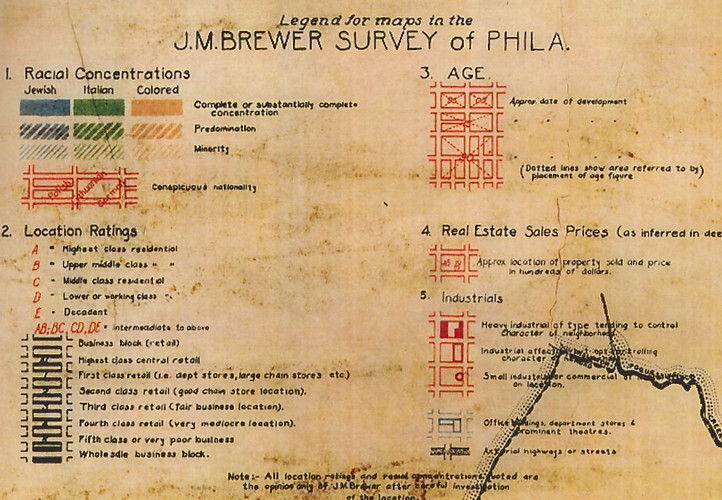
Brewer map legend
This map is discussed more in depth in our article about Baldwin Park here.
World War I and II created job opportunities in Philadelphia, and provided an economic draw for Blacks moving from the southern states. The ads above for Colored renters and buyers may be innocent niche marketing, or there could be other reasons. The Philadelphia-born American Friends Service Committee, for example, was a Quaker organization that would buy houses in White neighborhoods and sell only to Blacks in an attempt to facilitate integration (see outside article about the Concord Park integrated development here). Or, it could also be a symptom of blockbusting. Realtors would move Blacks into predominately White neighborhoods in order to lower property values, buy the White-owned housing on the cheap, and sell or rent at inflated prices to economically advancing Blacks. Or developers with an eye on a strip of houses may invite Blacks into the neighborhood in order to lower home values and push Whites to move out. The developers would then let the housing they owned deteriorate until nearby home prices dropped and the block became ripe for private development with more upscale residences.
We can compare the federal census data from the Baldwin Park neighborhood from 1930 to 1950. The boundaries of the neighborhood for this research were Spring Garden Street to Vine and from 16th to 21st Street. In the 1930 census only fourteen houses were occupied by Blacks in the entire neighborhood, and almost all of the heads of household gave their birthplace as below the Mason-Dixon Line. Six of the houses occupied by Blacks were on the north side of the 1900 block of Callowhill Street. The 1931 Callowhill house mentioned above was occupied by two White families in 1930 (a total of 21 people). The other house mentioned above, 1941 Callowhill, is not noted in the census. These census figures from 1930 do not include the former church at 1938-1944 Buttonwood which had been used as a shelter for men. There were a total of 415 lodgers there, about 16% of whom were Black, most from the South.
By 1950, just on the north side of the 1900 block of Callowhill alone, there were fourteen houses occupied by Blacks, again with almost all heads of households from the South.
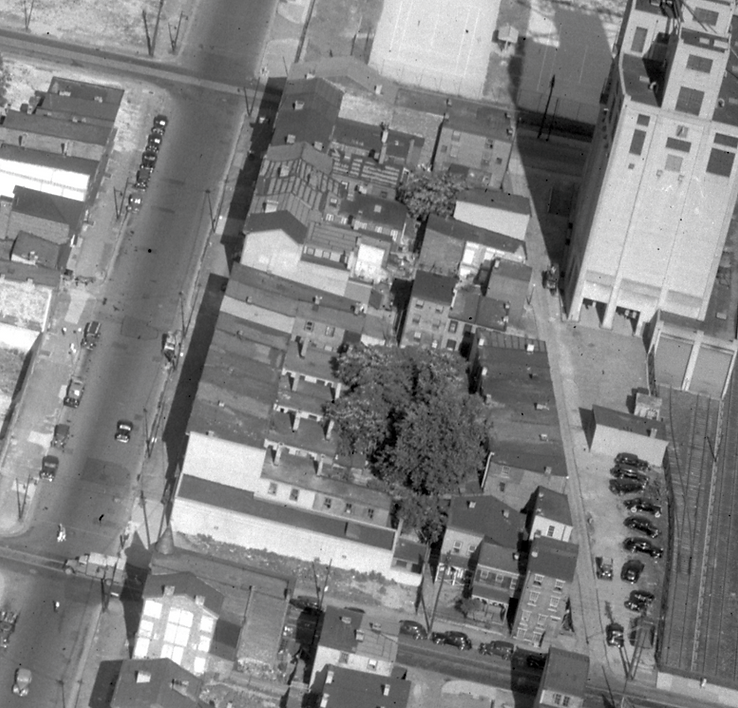
Aerial view of the block from the east in 1939.
In our article about the Rose Tattoo, it is stated that the Maltepes family owns the most property sites in the neighborhood today. Gertrude Phelan was the biggest non-corporate owner of properties in the neighborhood in the 1950s through the 1980s, starting in 1938 and ending with her last purchase in 1960. She purchased 1905 Callowhill from her parents in 1938, 1941 Callowhill Street mentioned above in 1939, and 1931 Callowhill in 1944. She picked up 23 other properties along Callowhill and Shamokin Streets over the next two decades. She died in 1977 and her son acquired her holdings in 1978 and held them until all were sold in 1986, as discussed below. Gertrude was the matriarch of a well-off family of prominent attorneys, her husband James Sr. having made his money in the paving business. She was the mother of James J. Phelan Jr., who was Assistant U.S. Attorney for the Eastern District of Pennsylvania and also a special Assistant Attorney General for the Commonwealth of Pennsylvania. Another son John was the Assistant District Attorney for Philadelphia before going into private practice.
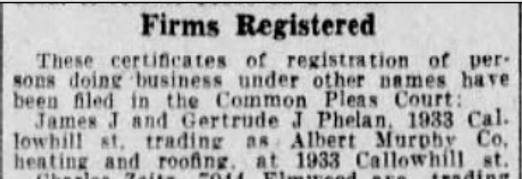
Business notice in the June 5, 1935 Philadelphia Inquirer.
Albert Murphy was Gertrude Phelan's father and in 1935 owned the building at 1933 Callowhill as well as at 1905 Callowhill. The purchases of 1933 and 1905 Callowhill were the first for the Phelans in the neighborhood, both purchased from Gertrude's mother Louise Murphy in 1938. Gertrude purchased 23 more sites over the next 22 years.

The northwest corner of Callowhill and 19th Streets in 1962.
Pat Maglio bought 1901 Callowhill Street in 1950 and moved his Mercury Menu Service there, capturing 95% of the menu printing business in the region. He died in 1991 and Mercury Menu moved to 1118 North 3rd Street. It went bankrupt in 2001.
The corner building was one of the few on the block that was built in the 20th century, replacing a building torn down in 1937. The buildings at 1901-1903 Callowhill and at 402 North 19th Street were sold by Maglio in 1989 to Granary Associates.
1901 Callowhill Street is the official address for the Granary Apartments.

1962 photo of the F. A. Mitchell Co. on the northeast corner of 20th and Callowhill Streets. Mitchell later expanded into another building at 1844 Callowhill in the 1970s. F. A. Mitchell was on a crew team in 1880 with William Bement Jr., whose father had a machine shop at the northwest corner of 20th and Callowhill. By 1889 Mitchell opened his hardware store opposite. Mitchell's business would be at 20th and Callowhill, then 19th and Callowhill, until the business was dissolved in 1988. Quite a run in the neighborhood!
In 1962 the north side of Callowhill had only two vacant lots: 1911 and 1925. The visible gap halfway down the block is Uber Street, which no longer exists on this block.
Note that Callowhill Street was one-way going east in 1962.
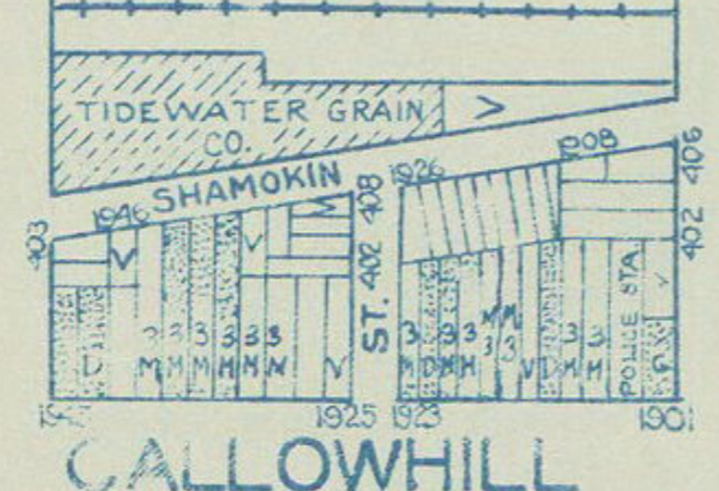
Portion of 1962 land use map
20th Street runs vertically on the left, north is at top.
The letter D with stippling represents a single-family house with first floor commercial use. The letter M represents a multifamily dwelling; M with stippling represents multifamily with a first floor commercial use. The letter V represents vacant land. A G is a garage, but it was the garage for delivery vehicles of Mercury Menu. A rectangle with no lettering is a single or two-family dwelling. Stippling with no lettering denotes purely commercial use.

Photo of a revised 1958 Sanborn fire insurance map from the map collection at the Parkway Central Library.
Most of the buildings along Callowhill Street are apartment buildings, except for a few single-family households (D) and a few stores or businesses (S). Note the four-foot-wide alleys that allow access to the rear of every house from the street. The eastern half of Shamokin Street would have looked very similar to today's 1800 block of Carlton Street, although the homes on Shamokin were only twelve feet wide. For comparison, the houses on the east half of Callowhill were 15 feet wide and west of Uber Street the houses were 17 feet wide.
Almost all the properties in the 1962 land use map were owned in 1962 by Gertrude Phelan. The following were owned by the Baltimore Warehouse Company: the concrete granary, 402-408 Uber Street, 1934 Shamokin, and 1925-1927 Callowhill Street. Half of those were vacant lots by 1962. Interior designer Kenneth Parker bought the concrete granary and these other properties in 1978 at Sheriff's sale for $42,950, not including the liens on those properties. Parker lived in the top floors of the concrete granary and had his business offices on the bottom two floors, now the location of the Fine Wine and Good Spirits store.
In 1986 Mediq Inc., a Pennsauken, New Jersey based diversified healthcare services company headed by Bernard J. Korman, acquired the interior design firm of Kenneth Parker. That same year Mediq, under the name of its subsidiary Granary Associates, also purchased the granary building and Parker's adjacent properties. In 1986 Frank A. Phelan sold his holdings to Mediq for $1 million, those holdings including most of the properties along Callowhill and Shamokin Streets. In 1987, the only midblock building was Ozzie's Hydraulic-Jack Repair Shop at 1921 Callowhill, owned by Oswald Scappa and hemmed in by lots being bulldozed. He had held out until he made the only killing on the block, selling his building in 1987 for $360,000. By 1989 Granary Associates owned from 1901 to 1939 Callowhill Street, from 1912 to 1938 Shamokin, 402-408 Uber Street and 401-403 North 20th Street, plus the concrete granary. Granary Associates did not own 1941 Callowhill, 404-406 North 19th, or 1910 Shamokin Street.
That block was not in the footprint of the Franklin Town development announced in 1971, but by 1990 it would meet the same fate: bulldozed for a surface parking lot.
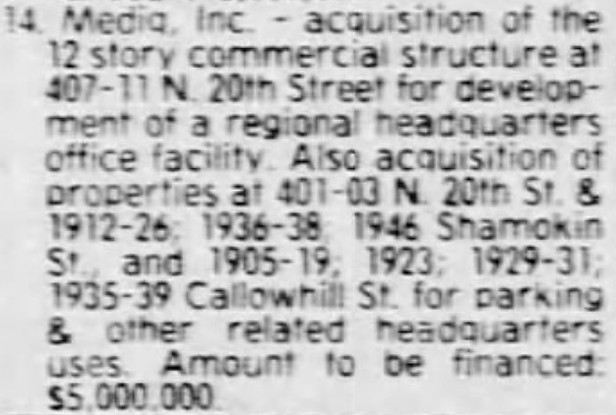
Real estate notice in the Philadelphia Daily News of April 29, 1986 listing the properties transferred from Frank J. Phelan to Mediq Inc..
In 1986 most of the buildings sketched on the 1962 land use map above were still there. With a few exceptions, this sale represents the concrete granary building and almost the entire block along Callowhill and Shamokin Streets from 19th to 20th Streets. Ozzie's hydraulic-lift repair shop at 1921 Callowhill was finally sold and was the last midblock building to be demolished, in 1987.
Korman Family Tangent
The Korman family is a prominent family in international real estate development and in philanthropy in Philadelphia. Here are a few connections to the neighborhood:
-
Hyman Korman was a Russian immigrant who first came into the Baldwin Park neighborhood with his purchase of the Preston Retreat in 1965. He demolished it and in 1975 built furnished extended-stay apartments called the KormanSuites, with a second tower added in 1989. Both towers went condo in 2003 as the City View Condominiums;
-
His philanthropist grandson Steven Korman has his name on the MANNA (Metropolitan Area Neighborhood Nutrition Alliance) building directly across from the concrete granary;
-
Steven's sister Lynne married Harold Honickman, who used a gift from Lynne's father Samuel to start a soda-bottling plant in 1957. This is the same company that was the regional distributor for Mike Maltepes (owner of the Rose Tattoo as discussed here) and his Country Pure juices. The new Jefferson Hospital building on Chestnut Street is named the Honickman building in recognition of his $50 million donation to the hospital;
-
and in 1986 the president of Mediq Inc. was Bernard J. Korman, second cousin of Steve and Lynne Korman.
End of Korman family tangent.

Aerial photo from 2012 from the east.
The buildings adjoining the parking lot are still there except for 1908 Shamokin Street. That building and 1941-1945 Callowhill (still there) were and are owned by subsidiaries of Mediq.
404 North 19th is also still there, owned by Mike Maltepes who also owns the Rose Tattoo across the street.
The concrete granary building was placed on the Philadelphia Register of Historic Buildings in 1981, and on the National Register of Historic Places one year later (for 47-page NRHP nomination form with photos from 1978 see here). Parker sold the granary in 1986 to Granary Associates, who used the building as office space until 2007 when Pearl Properties purchased the granary and the surface parking lot on Callowhill Street. The financial crisis ruined plans to build a 35-story apartment building on the lot, but by 2014 a nine-story 229-unit apartment building was completed. A plan to build a twelve-story addition atop the concrete granary was floated but encountered neighborhood opposition due to the height of the proposed building. There was also pressure applied by the Preservation Alliance and the city Historical Commission.

Architect rendering of proposed 12 story addition to the granary in 2010.
More on this plan at outside link here. Neighbors and the Historical Commission gave it a thumbs down.
(credit: Interface Studio Architects)

Image looking east down Shamokin Street. The image is from the 2010 proposal to the Historical Commission.
The bridge was to connect the two buildings on the second floor to allow the residents of the concrete granary to use amenities in the Callowhill Street building.
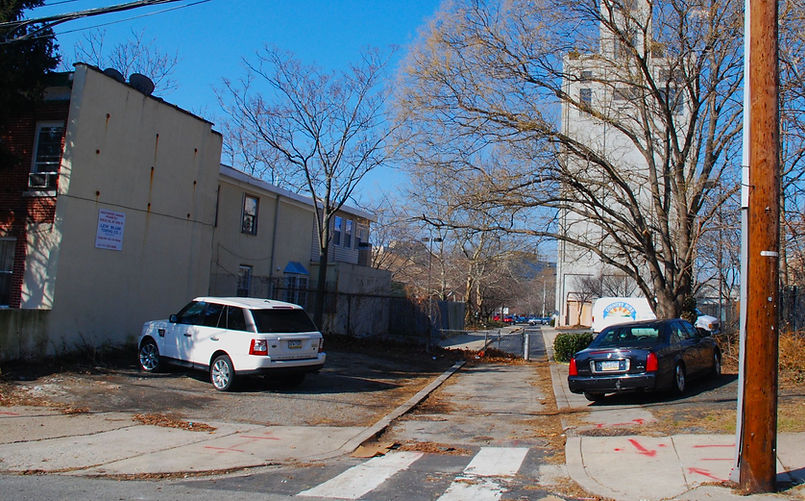
View down Shamokin Street looking west from 19th Street in 2010.
Mike Maltepes, the current owner of the Rose Tattoo, owns 404-406 North 19th Street on the left, two of seven original properties not incorporated into the Granary Apartments.
Notice on the right the white delivery truck with the logo for Mike's Country Pure beverages.
Photo credit Jim Fennell

Construction on the block in 2012
Photo credit Jim Fennell
In 2014 California-based Lowe Enterprises Investors purchased the new building. Lowe then sold to Chicago-based Lasalle Investment Management in 2017. The building is appraised at $80 million as of the 2026 tax year.
1941 Callowhill Street, the third house from the corner, was purchased by Dagon Series LLC in March of 2025 from the estate of Phillip M. Anderson, who died in 2018. Anderson, a Black man (in reference to the ad shown previously in this article), had purchased the house in 1975. The house was demolished in July 2025.

What's left of 1941 Callowhill Street as seen on July 15, 2025. The demolition of this home occurred 92 years after the first demolition on the block, noted above. There are only three other townhomes on the block, 1943 and 1945 Callowhill owned by 20th and Callowhill LP, and 404 North 19th owned by Mike Maltepes.
The Granary Apartments have an official address at 1901 Callowhill Street, but the building covers almost the entire block facing Callowhill and Shamokin Streets and the entrance to the lobby is at midblock. The building was completed in 2014 and offers 229 apartments, with one three-bedroom penthouse unit and the rest one- and two-bedroom units. The ground floor has 20,000 square feet of retail. The building is managed by Greystar, which also manages 1600 Callowhill (95 units), Logan Lofts (108 units), NorthxNorthwest (572 units) and the Alexander (264 units). Greystar therefore manages 1,268 rental units in the neighborhood, 45% of all the rental units in the neighborhood and 34% of all the housing units whether owned or rented. Greystar also manages the Hamilton apartments (576 units) at 1500 Hamilton Street just outside the Baldwin Park neighborhood. That's a major presence in the neighborhood and hopefully an influencer to stimulate membership in the Friends of Matthias Baldwin Park among its residents (see breakdown of membership rates by building here).
When most people spend money, like the seven cents a day ($25 annually) for a Friends membership, they are looking for a return on investment. Your seven cents a day buys items not provided by the City: new plantings in the central beds, new trees, dog waste bags, signage, educational tree tags, website fees, history articles, Movie Nights, the annual Halloween dog parade, the Little Free Library and children's story walks. The labor of all the volunteers who make this happen is free. If you don't think all this is worth it for yourself, then join the Friends group to make the Park a place of beauty and serenity for others in your community. There is quite a bit of subsidized housing in the area (Spring Garden Towers and other scattered sites), and quite a few older folks (the Fountain View), and Baldwin Park provides a free and local outdoor living room for all. So if personal return is not a motivator, do it for social justice and equity.



